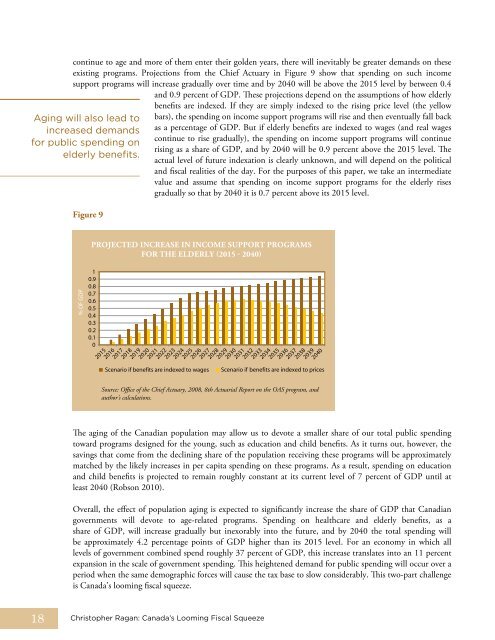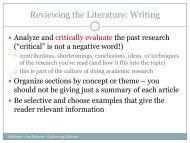Christopher Ragan, "Canada's Looming Fiscal Squeeze," November
Christopher Ragan, "Canada's Looming Fiscal Squeeze," November
Christopher Ragan, "Canada's Looming Fiscal Squeeze," November
You also want an ePaper? Increase the reach of your titles
YUMPU automatically turns print PDFs into web optimized ePapers that Google loves.
18<br />
continue to age and more of them enter their golden years, there will inevitably be greater demands on these<br />
existing programs. Projections from the Chief Actuary in Figure 9 show that spending on such income<br />
support programs will increase gradually over time and by 2040 will be above the 2015 level by between 0.4<br />
and 0.9 percent of GDP. These projections depend on the assumptions of how elderly<br />
benefits are indexed. If they are simply indexed to the rising price level (the yellow<br />
Aging will also lead to<br />
increased demands<br />
for public spending on<br />
elderly benefits.<br />
Figure 9<br />
% OF GDP<br />
bars), the spending on income support programs will rise and then eventually fall back<br />
as a percentage of GDP. but if elderly benefits are indexed to wages (and real wages<br />
continue to rise gradually), the spending on income support programs will continue<br />
rising as a share of GDP, and by 2040 will be 0.9 percent above the 2015 level. The<br />
actual level of future indexation is clearly unknown, and will depend on the political<br />
and fiscal realities of the day. For the purposes of this paper, we take an intermediate<br />
value and assume that spending on income support programs for the elderly rises<br />
gradually so that by 2040 it is 0.7 percent above its 2015 level.<br />
PRoJECTED INCREASE IN INCoME SuPPoRT PRoGRAMS<br />
FoR THE ELDERLy (2015 - 2040)<br />
1<br />
0.9<br />
0.8<br />
0.7<br />
0.6<br />
0.5<br />
0.4<br />
0.3<br />
0.2<br />
0.1<br />
0<br />
2015<br />
2016<br />
2017<br />
2018<br />
2019<br />
2020<br />
2021<br />
2022<br />
2023<br />
2024<br />
2025<br />
2026<br />
2027<br />
2028<br />
2029<br />
2030<br />
2031<br />
2032<br />
2033<br />
2034<br />
2035<br />
2036<br />
2037<br />
2038<br />
2039<br />
Scenario if benefits are indexed to wages Scenario if benefits are indexed to prices<br />
Source: Office of the Chief Actuary, 2008, 8th Actuarial Report on the OAS program, and<br />
author’s calculations.<br />
The aging of the Canadian population may allow us to devote a smaller share of our total public spending<br />
toward programs designed for the young, such as education and child benefits. As it turns out, however, the<br />
savings that come from the declining share of the population receiving these programs will be approximately<br />
matched by the likely increases in per capita spending on these programs. As a result, spending on education<br />
and child benefits is projected to remain roughly constant at its current level of 7 percent of GDP until at<br />
least 2040 (robson 2010).<br />
overall, the effect of population aging is expected to significantly increase the share of GDP that Canadian<br />
governments will devote to age-related programs. Spending on healthcare and elderly benefits, as a<br />
share of GDP, will increase gradually but inexorably into the future, and by 2040 the total spending will<br />
be approximately 4.2 percentage points of GDP higher than its 2015 level. For an economy in which all<br />
levels of government combined spend roughly 37 percent of GDP, this increase translates into an 11 percent<br />
expansion in the scale of government spending. This heightened demand for public spending will occur over a<br />
period when the same demographic forces will cause the tax base to slow considerably. This two-part challenge<br />
is Canada’s looming fiscal squeeze.<br />
<strong>Christopher</strong> <strong>Ragan</strong>: Canada’s <strong>Looming</strong> <strong>Fiscal</strong> <strong>Squeeze</strong><br />
2040





